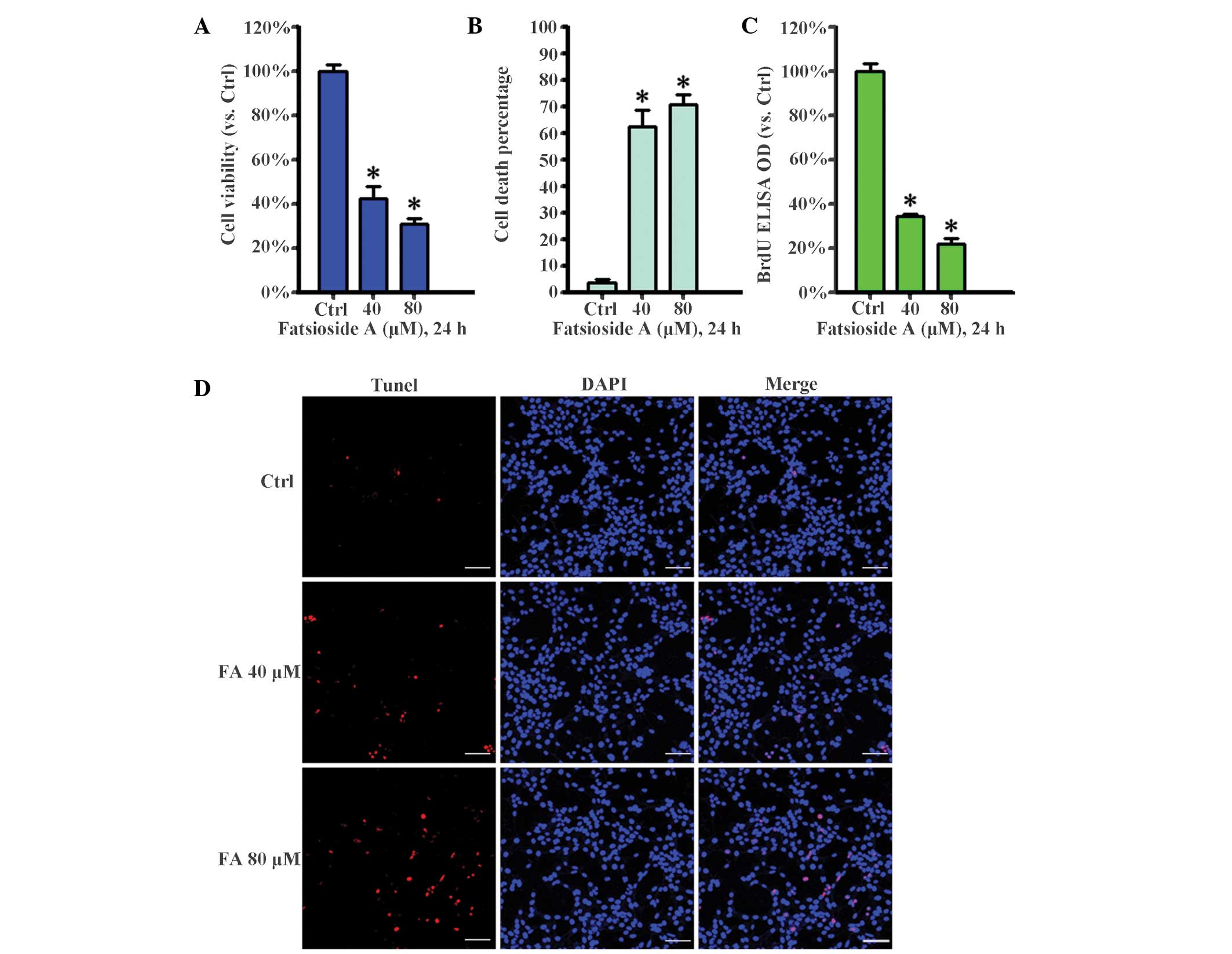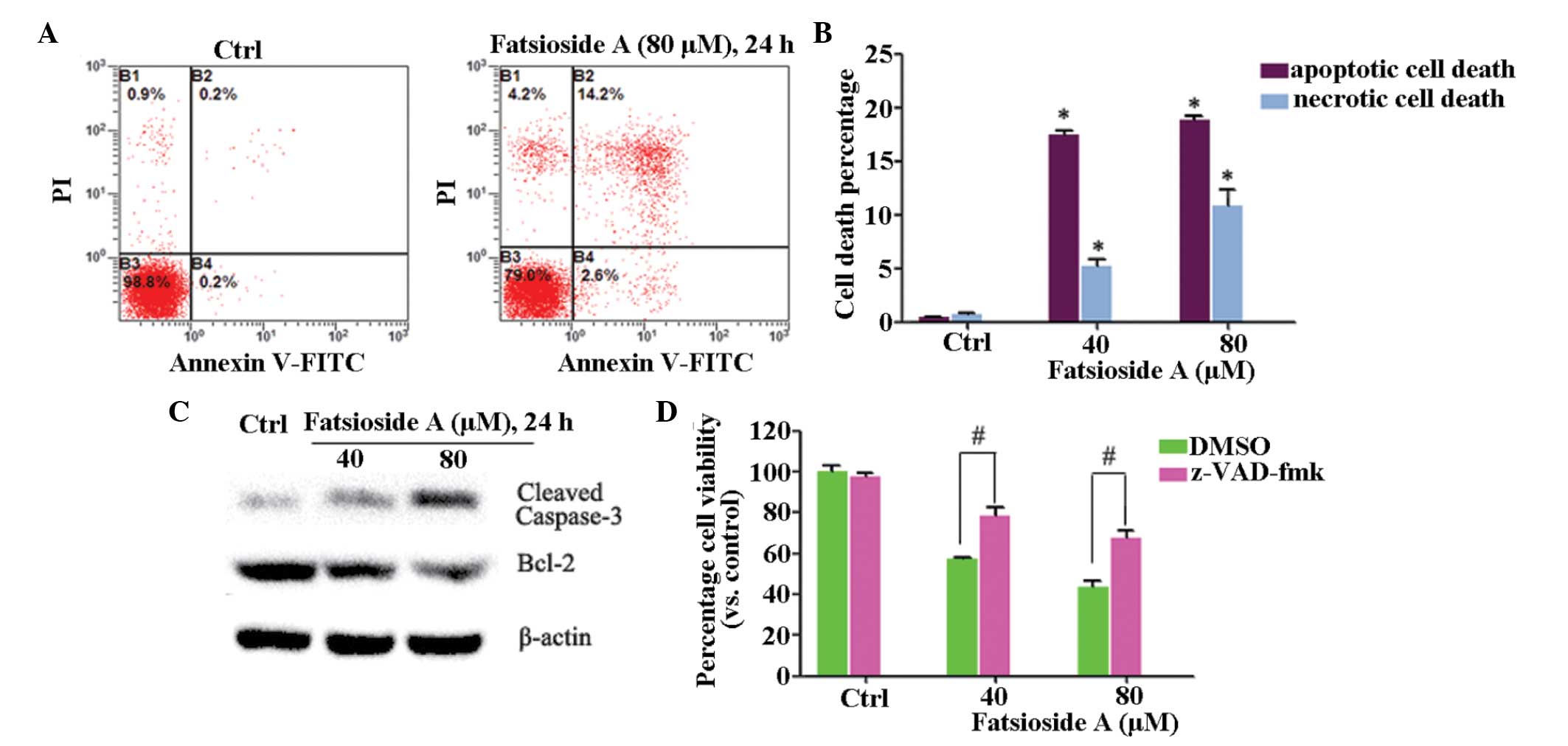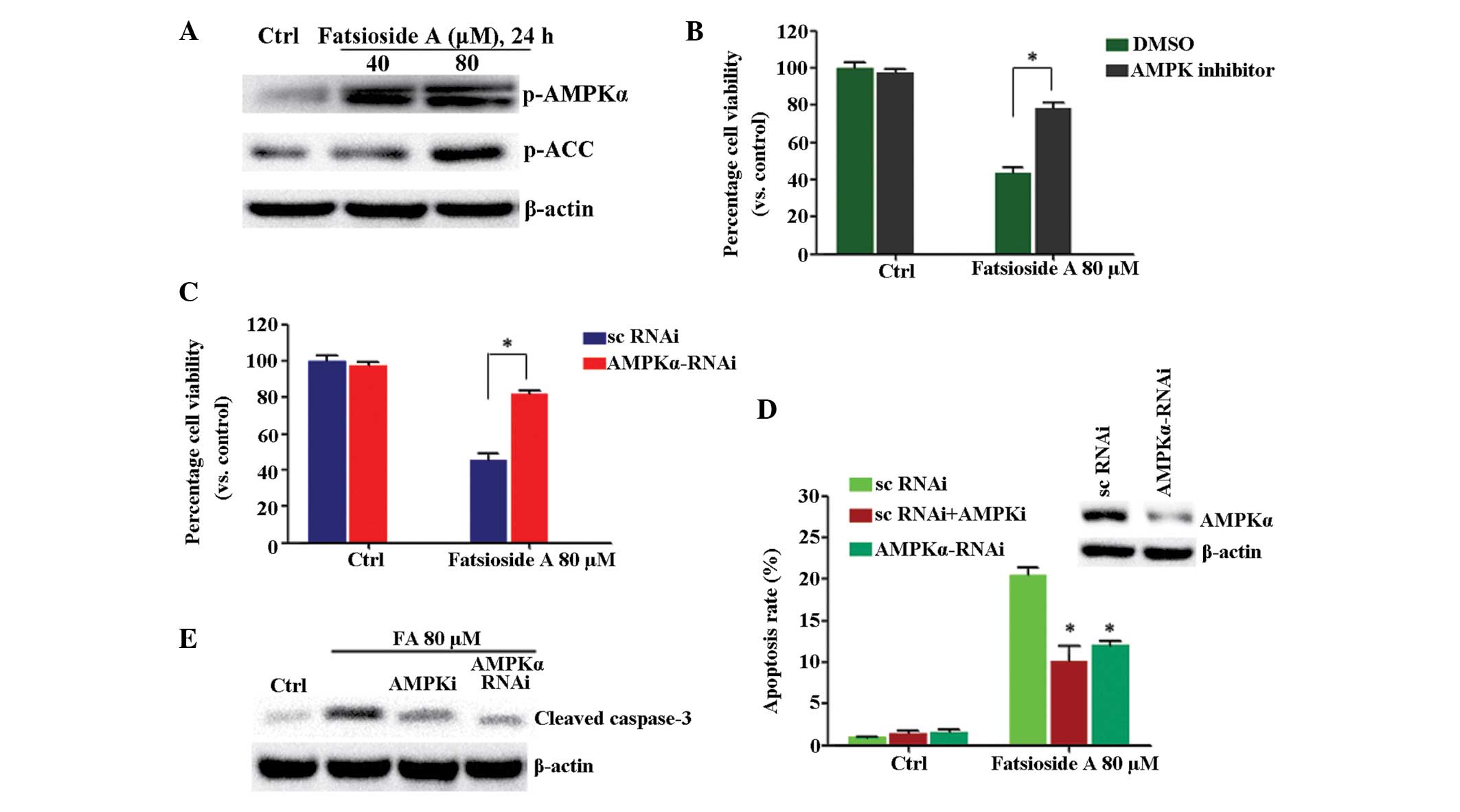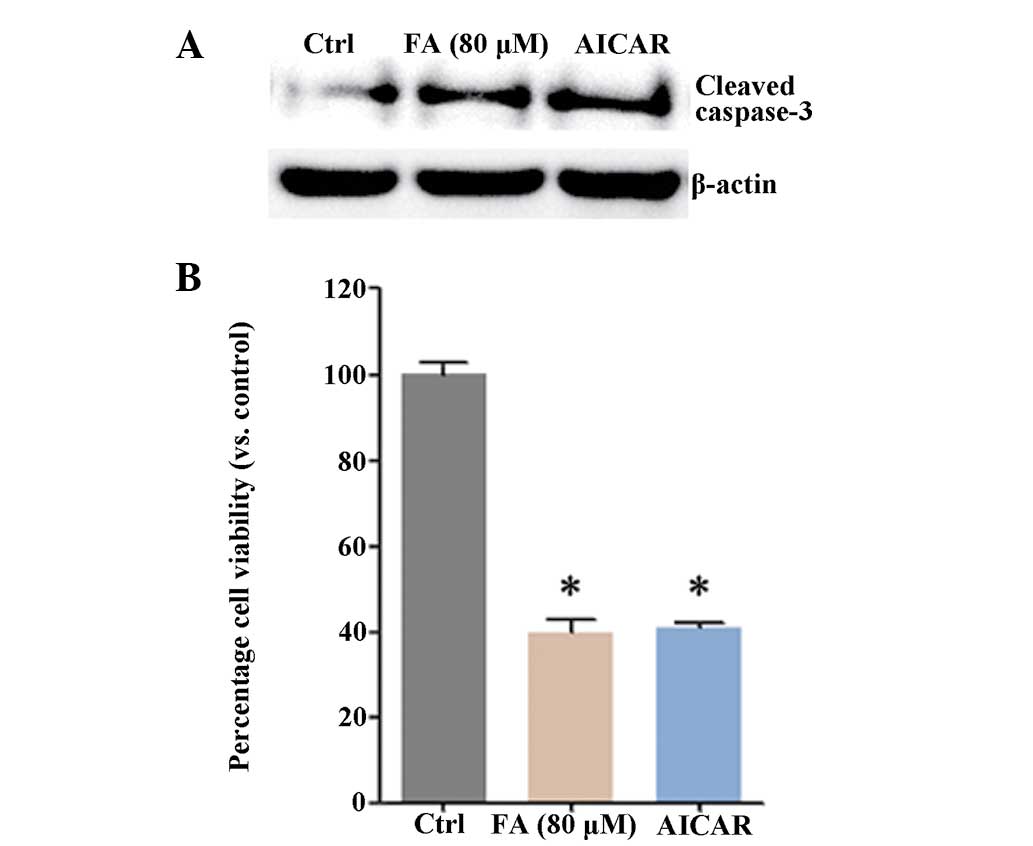Fatsioside A‑induced apoptotic death of HepG2 cells requires activation of AMP‑activated protein kinase
- Authors:
- Published online on: August 6, 2015 https://doi.org/10.3892/mmr.2015.4194
- Pages: 5679-5684
-
Copyright: © Zheng et al. This is an open access article distributed under the terms of Creative Commons Attribution License.
Abstract
Introduction
Hepatocellular carcinoma (HCC), the primary type of liver cancer, is one of the most malignant types of human tumor with poor prognosis (1). HCC accounts for >80% of all liver cancer and is diagnosed in >600,000 individuals annually globally (2,3). HCC has become one of the leading causes of cancer-associated mortality worldwide (4). There is currently no clinically proven curative therapy for advanced HCC (5), and a large percentage of cases of advanced HCC do not respond to chemotherapies, predominantly due to the high level of intrinsic and acquired chemoresistance (6). The successful elimination of cancer cells through apoptosis is the ultimate aim of chemotherapy (7,8). Apoptosis is an important process, which controls the growth and development of organisms (9), and the perturbation of apoptosis is considered to be a promising strategy for prevention and treatment of HCC.
Fatsioside A, a novel baccharane-type triterpenoid glycoside, is extracted from the fruits of Fatsia japonica (10). Fatsioside A can exert growth inhibition, cell cycle arrest and induce apoptosis in rat glioma C6 cells and human glioma U251 cells (10). Therefore, fatsioside A may be a promising novel candidate for adjunctive therapy against human tumors through the activation of cell death. However, its action on the HepG2 human HCC line have not been investigated and the exact mechanisms underlying the induction of apoptosis remain to be elucidated. The present study aimed to investigate the anticancer properties of fatsioside A in the HepG2 human HCC line, and to examine the underlying mechanisms by focusing on the AMP-activated protein kinase (AMPK) signaling cascade.
Under conditions of metabolic stress, including hypoxia, heat shock, oxidative stress and exercise, in which adenosine triphopshate is depleted, AMPK is activated and functions as a major metabolic switch to maintain energy homeostasis (11–16). This conserved heterotrimeric kinase has also been demonstrated to act as an intrinsic regulator of the mammalian cell cycle (17). In addition, AMPK is important in cancer cell survival and apoptosis (18–23), and a number of anticancer medicinal herb extracts activate AMPK-dependent cell death pathways (24–26). Previous studies have reported that fatsioside A may be a promising novel candidate for chemotherapy against human tumors through inducing cell death (10), however, the potential roles and underlying mechanisms of AMPK in mediating fatsioside A-induced cancer cell death remain to be fully elucidated Therefore, the present study aimed to investigate whether AMPK activation is important for fatsioside A-induced apoptotic death in the HepG2 HCC cells.
Materials and methods
Materials
Fatsioside A was provided by the College of Pharmaceutical Sciences, Zhejiang University (Hangzhou, China), which was dissolved in dimethylsulfoxide (DMSO) at 0.8 mM and diluted with fresh medium to obtain the desired concentration. The 3-(4, 5-dimetryl-thiazol-2-yl)-2, 5-diphenyltetrazolium bromide (MTT) assay was purchased from Cell Signaling Technology, Inc. (Danvers, MA, USA). Antibodies specific for phosphorylated (p-)AMPKα (rabbit anti-human polyclonal antibody; cat. no. SAB4503754; Sigma-Aldrich, St. Louis, MO, USA), AMPKα (rabbit anti-human polyclonal antibody; cat. no. A3730; Sigma-Aldrich), cleaved caspase-3 (rabbit anti-human polyclonal antibody; cat. no. C9598; Sigma-Aldrich), B-cell lymphoma (Bcl)-2 (rabbit anti-human polyclonal antibody; cat. no. PRS3335; Sigma-Aldrich) and β-actin (mouse anti-human monoclonal antibody; cat. no. A1978; Sigma-Aldrich). The secondary antibodies were obtained from Santa Cruz Biotechnology, Inc. (Dallas, TX, USA). 5-aminoimidazole-4-carboxyam ide-1-β-D-ribofuranoside (AICAR) was purchased from Sigma-Aldrich. Z-VAD-fmk and compound C were purchased from Calbiochem (Darmstadt, Germany).
Cell culture
The HepG2 cell line was obtained from the Chinese Academy of Sciences Cell Bank (Shanghai, China). The cells were maintained in Dulbecco's modified Eagle's medium (DMEM; Sigma-Aldrich), supplemented with 10% fetal bovine serum (FBS; Invitrogen Life Technologies, Carlsbad, CA, USA), penicillin/streptomycin (1:100; Sigma-Aldrich) and 4 mM L-glutamine (Sigma-Aldrich) in a CO2 incubator at 37°C. When the cells reached 80% confluence, they were divided into three plates. The subsequent experiments were performed when the cells reached 50–60% confluence.
MTT assay
An MTT assay was used to examine the effects of fatsioside A on the proliferation of the HepG2 cells. Briefly, the cells were seeded into 96-well plates at a density of 5×103 cells/well in 200 µl medium. The cells in the wells were then treated with various concentrations (40 or 80 µM) of fatsioside A and were cultured for 24 h at 37°C. At the end of culture, 0.5 mg/ml MTT in 20 µl phosphate-buffered saline (PBS) was added to each well and the cells were incubated for 4 h at 37°C. An enzyme-labeled instrument (Thermo Fisher Scientific, Waltham, MA, USA) was used to measure the absorbance of each well at 570 nm. Data were calculated from three independent experiments.
Cell apoptosis assay
An Annexin V Apoptosis Detection kit (Beyotime Institute of Biotechnology, Shanghai, China) was used to analyze the effects of fatsioside A on the apoptosis of the HepG2 cells. Briefly, 1,000,000 HepG2 cells with the indicated treatment were stained with fluorescein isothiocyanate (FITC)-Annexin V and propidium iodide (PI). The early (annexin V+/PI−) and late (annexin V+/PI+) apoptotic cells were sorted using a fluorescence-activated cell sorting machine (FACSCalibur; BD Biosciences, Franklin Lakes, NJ, USA). All experiments were performed in triplicate.
BrdU incorporation assay
The HepG2 cells were seeded at a density of 1×105 cells/well in 0.5 ml DMEM containing 10% FBS into 48-well tissue culture plates. The cells were serum-starved for 24 h and then exposed to various concentrations (40 or 80 µM) of fatsioside A for 24 h at 37°C. The cell proliferation was assessed by examining the incorporation of BrdU using a BrdU ELISA colorimetric assay (Roche Diagnostics, Indianapolis, IN, USA), according to the manufacturer's instructions. The ELISA optical density value of the treatment groups were normalized to that of the untreated control group. Each condition was assessed in triplicate.
Trypan blue staining
The numbers of 'dead' HepG2 cells (trypan blue-positive) following the indicated treatments were recorded, and the percentage of cell death in the HepG2 was calculated by the number of the trypan blue dye-positive cells divided by the total number of the cells.
TUNEL staining
Apoptotic cells was also detected using a TUNEL kit (Sigma-Aldrich) according to the manufacturer's instructions. Briefly, cells were cultured on cover slips. After Fatsioside A (40 or 80 µM) treatment for 24 h, the cells were fixed in 4% paraformaldehyde solution in PBS for 30 min at room temperature. The cells were then incubated with a methanol solution containing 0.3% H2O2 for 30 min at room temperature to block endogenous peroxidase activity, and then incubated in the TUNEL reaction mixture for 60 min at 37°C, counterstained with DAPI, then finally visualized by fluorescence microscopy (DM4000B; Leica Microsystems GmbH, Wetzlar, Germany).
Western blot analysis
Whole cellular protein was extracted from the HepG2 cells using lysis buffer for western blot analysis. Briefly, the cells were lysed in radioimmunoprecipitation assay buffer (Sigma-Aldrich) for 30 min on ice. Protein levels were quantified using the bicinchoninic acid method. Equal quantities of protein (30 µg/lane) were separated by 5–12% sodium dodecyl sulfate-polyacrylamide gel electrophoresis (SDS-PAGE) and then transferred onto nitrocellulose blotting membranes (EMD Millipore, Billerica, MA, USA). The membranes were blocked in tris-buffered saline with Tween 20 (Sigma-Aldrich) containing 5% non-fat dry milk (w/v) for 2 h and incubated with primary antibodies at 1:1,000 dilution overnight at 4°C, followed by incubation with corresponding horseradish peroxidase-conjugated secondary antibodies at room temperature for 2 h. Protein bands were visualized using chemiluminescence detection (EMD Millipore).
RNA interference (RNAi)
The following RNAi sequences: 5′-GCAUAUGCUGCAGGUAGAU-3′ and 5′-AAGGAAAGTGAAGGTGGGCAA-3′, targeted against human AMPKα1/2 were synthesized by Genewiz, Inc. (Suzhou, China). Non-sense control RNAi was purchased from Santa Cruz Biotechnology, Inc, and was used as an RNAi-negative control. Transfection was performed, as described previously (27). Briefly, the HepG2 cells were cultured on a six-well plate to 60% confluence in antibiotic- and serum-free medium at 37°C. The targeted and control RNAi (100 µM) and 3.0 µl Lipofectamine PLUS Reagent (Invitrogen Life Technologies) were diluted in 90 µl small interfering RNA dilution buffer (Santa Cruz Biotechnology, Inc.), and 3 µl Lipofectamine LTX (Sigma-Aldrich) was added. The transfection complex was then added to the wells containing 1 ml DMEM for 12 h, with a final RNAi concentration of 100 nM. Growth medium was then added to the cells, which were cultured for an additional 48 h at 37°C. The expression levels of the target proteins in the transfected cells were assessed using western blot analysis. Only the cells exhibiting significant target protein-knockdown were used for the experiments.
Statistical analysis
The data are presented as the mean ± standard deviation of three independent experiments. Differences between two mean values were evaluated using Student's t-test and P<0.05 was considered to indicate a statistically significant difference. Statistical analyses were performed using SPSS software 19.0 (SPSS, Inc., Chicago, IL, USA).
Results
Fatsioside A inhibits the survival and proliferation of HepG2 cells
The present study examined the effect of fatsioside A on HepG2 cell survival and proliferation. Cell viability was evaluated using an MTT assay. The results, as shown in Fig. 1A, clearly indicated that fatsioside A at concentrations of 40 and 80 µM markedly inhibited HepG2 cell survival. In addition, the number of trypan blue-positive, 'dead', cells increased sharply following fatsioside A treatment at 40 and 80 µM (Fig. 1B). The effect of fatsioside A on HepG2 cell proliferation was also examined. Using a BrdU incorporation assay, the present study demonstrated that fatsioside A suppressed HepG2 cell proliferation (Fig. 1C). Furthermore, a TUNEL assay revealed that, compared with the control group, the number of tunnel-positive 'dead' cells increased markedly following fatsioside A treatment at concentrations of 40 and 80 µM (Fig. 1D). Taken together, these results suggested that fatsioside A significantly inhibited the survival and proliferation of the HepG2 cells.
Fatsioside A induces apoptotic and necrotic death of HepG2 cells
The results described above indicated that fatsioside A inhibited HepG2 cell survival and proliferation; therefore, the present study subsequently assessed whether cell apoptosis was involved in this effect. As shown in Fig. 2A and B, fatsioside A (40 and 80 µM) induced early (Annexin V+/PI−) and late (Annexin V+/PI+) apoptosis in the HepG2 cells. In addition, fatsioside A also caused caspase-3 cleavage and Bcl-2 degradation (Fig. 2C). Notably, fatsioside A also induced necrotic (Annexin V−/PI+) HepG2 cell death (Fig. 2A and B). Furthermore, the results of the cell viability assay results, as shown in Fig. 2D, demonstrated that z-VAD-fmk, a general caspase inhibitor, suppressed, but did not reverse, fatsioside A-induced HepG2 loss of viability, indicating that apoptotic and necrotic death accounted for the fatsioside A-induced cytotoxicity in the HepG2 cells.
Activation of AMPK is involved in fatsioside A-induced cytotoxicity in HepG2 cells
As shown in Fig. 3A, fatsioside A induced significant AMPK activation in the HepG2 cells, as the expression levels of p-AMPKα and the downstream ACC in HepG2 cells were significantly increased following fatsioside A treatment. Notably, AMPK inhibition by its inhibitor, compound C or by AMPKα-RNAi suppressed fatsioside A-induced loss of cell viability (Fig. 3B and C). Fatsioside A-induced apoptosis and cleavage of caspase-3 was also inhibited by AMPK inhibition (Fig. 3D and E). The AICAR AMPK activator also inhibited HepG2 cell survival (Fig. 4A and B). The above results indicated that activation of AMPK was involved in fatsioside A-induced cytotoxicity in HepG2 cells.
Discussion
HCC is known to be one of the most life-threatening types of tumor in humans. The effects of current antitumor therapies in HCC are limited (28–30) and, as HCC cells are resistant to apoptosis, patients with HCC usually have a poor prognosis. Therefore, examination of potential novel therapy targeting their inherent apoptosis-resistant phenotype is essential.
The present study revealed that fatsioside A markedly inhibited the survival and proliferation of HepG2 cells and induced apoptotic and necrotic death of the HepG2 cells. Furthermore, this effect was found to be exerted by activation of the AMPK cascade.
In line with previously published data on glioma (10), the present study observed that fatsioside A significantly inhibited the proliferation of HepG2 cells. One of the novel findings of the present study is the confirmation that the fatsioside A-induced reduction in the viability of HepG2 cells occurred through apoptosis, which was elucidated following the application of Annexin V-FITC/PI double staining. Apoptosis is a physiological phenomenon (31). The significance of apoptosis is to remove senescent cells and over functioning cells, including activated T cells (32–34). Deregulation of apoptosis is associated with the pathogenesis of a number of disorders, including tumor cell growth. Thus, one of the predominant strategies used to treat tumors is to induce the apoptosis of tumor cells (35). The results of the present study suggested that fatsioside A can disturb the inherent apoptosis-resistant ability of HepG2 cells. Of note, it was also found that fatsioside A induced necrotic death of the HepG2 cells, as the z-VAD-fmk caspase inhibitor suppressed, but did not reverse, fatsioside A-induced loss of HepG2 viability.
Previous studies have demonstrated that cellular stress-activated AMPK promotes cell apoptosis (36), and such an effect by AMPK occurs through regulating the downstream signals of AMPK, including c-Jun N-terminal kinase, p53 and mammalian target of rapamycin (37–39). In addition, anticancer chemotherapies, including taxol and temozolomide activate the AMPK-dependent apoptosis pathways (40,41). Resveratrol, capsaicin and EGCG anticancer plant extract-induced cancer cell death also requires AMPK activation (18,42,43). In the present study, significant AMPK activation was observed in the fatsioside A-treated HepG2 cells. Inhibition of AMPK by RNAi or compound C suppressed fatsioside A-induced apoptosis in the HepG2 cells. By contrast, HepG2 cell viability was inhibited by the AICAR AMPK activator. These results suggested that AMPK activation is required for the induction of the anticancer effects of fatsioside A in HepG2 cells.
However, of note, AMPK inhibition reduced, but did not reverse HepG2 cytotoxicity-induced by fatsioside A in the present study. This may be due to the incomplete inhibition of AMPK by the methods used in the present study (RNAi or compound C), however, it is more likely that AMPK activation is among several mechanisms activated by fatsioside A to mediate HepG2 cell death. Other signals, which are independent of AMPK activation and induced by fatsioside A require further investigation. Although the present study confirmed AMPK activation by fatsioside A, the potential upstream signal for this activation remains to be elucidated.
Acknowledgments
The authors would like to thank Dr Liu from the Department of Pharmacology and Neurology, Emory University (Atlanta, GA, USA) for the critical reading and modification of the manuscript.
References
|
Zhang JP, Yan J, Xu J, Pang XH, Chen MS, Li L, Wu C, Li SP and Zheng L: Increased intratumoral IL-17-producing cells correlate with poor survival in hepatocellular carcinoma patients. J Hepatol. 50:980–989. 2009. View Article : Google Scholar : PubMed/NCBI | |
|
Srivatanakul P, Sriplung H and Deerasamee S: Epidemiology of liver cancer: An overview. Asian Pac J Cancer Prev. 5:118–125. 2004.PubMed/NCBI | |
|
Ferenci P, Fried M, Labrecque D, Bruix J, Sherman M, Omata M, Heathcote J, Piratsivuth T, Kew M, Otegbayo JA, et al: Hepatocellular carcinoma (HCC): A global perspective. J Clin Gastroenterol. 44:239–245. 2010. View Article : Google Scholar : PubMed/NCBI | |
|
Yang JD and Roberts LR: Hepatocellular carcinoma: A global view. Nat Rev Gastroenterol Hepatol. 7:448–458. 2010. View Article : Google Scholar : PubMed/NCBI | |
|
Llovet JM: Updated treatment approach to hepatocellular carcinoma. J Gastroenterol. 40:225–235. 2005. View Article : Google Scholar : PubMed/NCBI | |
|
Villanueva A and Llovet JM: Targeted therapies for hepatocellular carcinoma. Gastroenterology. 140:1410–1426. 2011. View Article : Google Scholar : PubMed/NCBI | |
|
Sun Y and Peng Z: Programmed cell death and cancer. Postgrad Med J. 85:134–140. 2009. View Article : Google Scholar : PubMed/NCBI | |
|
Ashkenazi A and Herbst RS: To kill a tumor cell: The potential of proapoptotic receptor agonists. J Clin Invest. 118:1979–1990. 2008. View Article : Google Scholar : PubMed/NCBI | |
|
Pérez-Garijo A, Martín FA and Morata G: Caspase inhibition during apoptosis causes abnormal signalling and developmental aberrations in Drosophila. Development. 131:5591–5598. 2004. View Article : Google Scholar : PubMed/NCBI | |
|
Yu S, Ye X, Xin W, Xu K, Lian XY and Zhang Z: Fatsioside A, a rare baccharane-type glycoside inhibiting the growth of glioma cells from the fruits of fatsia japonica. Planta Med. 80:315–320. 2014. View Article : Google Scholar : PubMed/NCBI | |
|
Papandreou I, Lim AL, Laderoute K and Denko N: Hypoxia signals autophagy in tumor cells via AMPK activity, independent of HIF-1, BNIP3 and BNIP3L. Cell Death Differ. 15:1572–1581. 2008. View Article : Google Scholar : PubMed/NCBI | |
|
Laderoute KR, Amin K, Calaoagan JM, Knapp M, Le T, Orduna J, Foretz M and Viollet B: 5-AMP-activated protein kinase (AMPK) is induced by low-oxygen and glucose deprivation conditions found in solid-tumor microenvironments. Mol Cell Biol. 26:5336–5347. 2006. View Article : Google Scholar : PubMed/NCBI | |
|
Schulz E, Anter E, Zou MH and Keaney JF Jr: Estradiol-mediated endothelial nitric oxide synthase association with heat shock protein 90 requires adenosine monophosphate-dependent protein kinase. Circulation. 111:3473–3480. 2005. View Article : Google Scholar : PubMed/NCBI | |
|
Ceolotto G, Gallo A, Papparella I, Franco L, Murphy E, Iori E, Pagnin E, Fadini GP, Albiero M, Semplicini A and Avogaro A: Rosiglitazone reduces glucose-induced oxidative stress mediated by NAD (P) H oxidase via AMPK-dependent mechanism. Arterioscl Throm Vasc Biol. 27:2627–2633. 2007. View Article : Google Scholar | |
|
Horie T, Ono K, Nagao K, Nishi H, Kinoshita M, Kawamura T, Wada H, Shimatsu A, Kita T and Hasegawa K: Oxidative stress induces GLUT4 translocation by activation of PI3K/Akt and dual AMPK kinase in cardiac myocytes. J Cell Physiol. 215:733–742. 2008. View Article : Google Scholar : PubMed/NCBI | |
|
Jorgensen SB and Rose AJ: How is AMPK activity regulated in skeletal muscles during exercise? Front Biosci. 13:5589–5604. 2007. | |
|
Jones RG, Plas DR, Kubek S, Buzzai M, Mu J, Xu Y, Birnbaum MJ and Thompson CB: AMP-activated protein kinase induces a p53-dependent metabolic checkpoint. Mol Cell. 18:283–293. 2005. View Article : Google Scholar : PubMed/NCBI | |
|
Hwang JT, Ha J, Park IJ, Lee SK, Baik HW, Kim YM and Park OJ: Apoptotic effect of EGCG in HT-29 colon cancer cells via AMPK signal pathway. Cancer Lett. 247:115–121. 2007. View Article : Google Scholar | |
|
Hwang JT, Ha J and Park OJ: Combination of 5-fluorouracil and genistein induces apoptosis synergistically in chemo-resistant cancer cells through the modulation of AMPK and COX-2 signaling pathways. Biochem Bioph Res Commun. 332:433–440. 2005. View Article : Google Scholar | |
|
Shaw RJ, Kosmatka M, Bardeesy N, Hurley RL, Witters LA, DePinho RA and Cantley LC: The tumor suppressor LKB1 kinase directly activates AMP-activated kinase and regulates apoptosis in response to energy stress. Proc Natl Acad Sci USA. 101:3329–3335. 2004. View Article : Google Scholar : PubMed/NCBI | |
|
Sid B, Glorieux C, Valenzuela M, Rommelaere G, Najimi M, Dejeans N, Renard P, Verrax J and Calderon PB: AICAR induces Nrf2 activation by an AMPK-independent mechanism in hepato-carcinoma cells. Biochem Pharmacol. 91:168–180. 2014. View Article : Google Scholar : PubMed/NCBI | |
|
Xu Q, Liu X, Zheng X, Yao Y, Wang M and Liu Q: The transcriptional activity of Gli1 is negatively regulated by AMPK through Hedgehog partial agonism in hepatocellular carcinoma. Int J Mol Med. 34:733–741. 2014.PubMed/NCBI | |
|
Cheng J, Huang T, Li Y, Guo Y, Zhu Y, Wang Q, Tan X, Chen W, Zhang Y, Cheng W, et al: AMP-activated protein kinase suppresses the in vitro and in vivo proliferation of hepatocellular carcinoma. PLoS One. 9:e932562014. View Article : Google Scholar : PubMed/NCBI | |
|
Johnson JJ: Carnosol: A promising anti-cancer and anti-inflammatory agent. Cancer Lett. 305:1–7. 2011. View Article : Google Scholar : PubMed/NCBI | |
|
Kim T, Davis J, Zhang AJ, He X and Mathews ST: Curcumin activates AMPK and suppresses gluconeogenic gene expression in hepatoma cells. Biochem Biophys Res Commun. 388:377–382. 2009. View Article : Google Scholar : PubMed/NCBI | |
|
HemaIswarya S and Doble M: Potential synergism of natural products in the treatment of cancer. Phytother Res. 20:239–249. 2006. View Article : Google Scholar : PubMed/NCBI | |
|
Chiu YL, Ali A, Chu CY, Cao H and Rana TM: Visualizing a correlation between siRNA localization, cellular uptake, and RNAi in living cells. Chem Biol. 11:1165–1175. 2004. View Article : Google Scholar : PubMed/NCBI | |
|
Bruix J and Sherman M; American Association for the Study of Liver Diseases: Management of hepatocellular carcinoma: An update. Hepatology. 53:1020–1022. 2011. View Article : Google Scholar : PubMed/NCBI | |
|
Bruix J and Sherman M; Practice Guidelines Committee; American Association for the Study of Liver Diseases: Management of hepatocellular carcinoma. Hepatology. 42:1208–1236. 2005. View Article : Google Scholar : PubMed/NCBI | |
|
El-Serag HB and Rudolph KL: Hepatocellular carcinoma: Epidemiology and molecular carcinogenesis. Gastroenterology. 132:2557–2576. 2007. View Article : Google Scholar : PubMed/NCBI | |
|
Elmore S: Apoptosis: A review of programmed cell death. Toxicol Pathol. 35:495–516. 2007. View Article : Google Scholar : PubMed/NCBI | |
|
Skulachev V: Bioenergetic aspects of apoptosis, necrosis and mitoptosis. Apoptosis. 11:473–485. 2006. View Article : Google Scholar : PubMed/NCBI | |
|
Hunter AM, LaCasse EC and Korneluk RG: The inhibitors of apoptosis (IAPs) as cancer targets. Apoptosis. 12:1543–1568. 2007. View Article : Google Scholar : PubMed/NCBI | |
|
Plumas J, Chaperot L, Richard MJ, Molens JP, Bensa JC and Favrot MC: Mesenchymal stem cells induce apoptosis of activated T cells. Leukemia. 19:1597–1604. 2005. View Article : Google Scholar : PubMed/NCBI | |
|
Fesik SW: Promoting apoptosis as a strategy for cancer drug discovery. Nat Rev Cancer. 5:876–885. 2005. View Article : Google Scholar : PubMed/NCBI | |
|
Motoshima H, Goldstein BJ, Igata M and Araki E: AMPK and cell proliferation-AMPK as a therapeutic target for atherosclerosis and cancer. J Physiol. 574:63–71. 2006. View Article : Google Scholar : PubMed/NCBI | |
|
Lee YM, Uhm KO, Lee ES, Kwon J, Park SH and Kim HS: AM251 suppresses the viability of HepG2 cells through the AMPK (AMP-activated protein kinase)-JNK (c-Jun N-terminal kinase)-ATF3 (activating transcription factor 3) pathway. Biochem Bioph Res Commun. 370:641–645. 2008. View Article : Google Scholar | |
|
Duan X, Ponomareva L, Veeranki S and Choubey D: IFI16 induction by glucose restriction in human fibroblasts contributes to autophagy through activation of the ATM/AMPK/p53 pathway. Plos One. 6:e195322011. View Article : Google Scholar : PubMed/NCBI | |
|
Sugiyama M, Takahashi H, Hosono K, Endo H, Kato S, Yoneda K, Nozaki Y, Fujita K, Yoneda M, Wada K, et al: Adiponectin inhibits colorectal cancer cell growth through the AMPK/mTOR pathway. Int J Oncol. 34:339–344. 2009.PubMed/NCBI | |
|
Rocha GZ, Dias MM, Ropelle ER, Osório-Costa F, Rossato FA, Vercesi AE, Saad MJ and Carvalheira JB: Metformin amplifies chemotherapy-induced AMPK activation and antitumoral growth. Clin Cancer Res. 17:3993–4005. 2011. View Article : Google Scholar : PubMed/NCBI | |
|
Zhang WB, Wang Z, Shu F, Jin YH, Liu HY, Wang QJ and Yang Y: Activation of AMP-activated protein kinase by temozolomide contributes to apoptosis in glioblastoma cells via p53 activation and mTORC1 inhibition. J Biol Chem. 285:40461–40471. 2010. View Article : Google Scholar : PubMed/NCBI | |
|
Hwang JT, Kwak DW, Lin SK, Kim HM, Kim YM and Park OJ: Resveratrol induces apoptosis in chemoresistant cancer cells via modulation of AMPK signaling pathway. Ann NY Acad Sci. 1095:441–448. 2007. View Article : Google Scholar : PubMed/NCBI | |
|
Kim YM, Hwang JT, Kwak DW, Lee YK and Park OJ: Involvement of AMPK signaling cascade in capsaicin-induced apoptosis of ht-29 colon cancer cells. Ann NY Acad Sci. 1095:496–503. 2007. View Article : Google Scholar : PubMed/NCBI |













